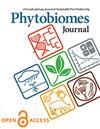Biocontrol agents establishment and their impact on rhizosphere microbiome and induced grapevine defenses is highly soil-dependent
IF 2.6
3区 生物学
Q2 MICROBIOLOGY
引用次数: 0
Abstract
With a reduction on available chemical treatments, there is an increased interest on biological control of grapevine trunk diseases. Few studies have investigated the impact of introducing beneficial microorganisms in rhizosphere, on the indigenous soil existent microbiome. In this study, we explored the effect of two biological control agents, Trichoderma atroviride SC1 (commercial product Vintec® from Certis Belchim, Ta SC1) and Bacillus subtilis PTA-271 (Bs PTA-271), on the grapevine rhizosphere bacterial and fungal microbiome, and on plant defense expression, using High-Throughput Amplicon Sequencing and qPCR, respectively. Additionally, we quantified both Ta SC1 and Bs PTA-271 in rhizosphere overtime using digital droplet PCR. The fungal microbiome was more affected by factors such as soil type, BCA treatment, and sampling time than bacterial microbiome. Specifically, Ta SC1 application produced negative impacts on fungal diversity, while applications of BCAs did not affect bacterial diversity. Interestingly, the survival and establishment of both BCAs showed opposite trends depending on the soil type, indicating that the physicochemical properties of soils have a role on BCA establishment. Fungal co-occurrence networks were less complex than bacterial networks, but highly impacted by Ta SC1 application. Soils treated with Ta SC1, presented more complex and stable co-occurrence networks, with a higher number of positive correlations. Induced grapevine defenses also differed according to the soil, being more affected by BCA inoculation on sandy soil.生物防治剂的建立及其对根际微生物群和诱导葡萄植株防御的影响是高度依赖土壤的
随着可用化学处理方法的减少,人们对葡萄树干病害的生物防治越来越感兴趣。在根际引入有益微生物对原生土壤微生物群的影响研究较少。在本研究中,我们分别利用高通量扩增子测序和qPCR技术,研究了两种生物防治剂——atroviride Trichoderma SC1 (Certis Belchim的商品化产品Vintec®,Ta SC1)和枯草芽孢杆菌PTA-271 (Bs PTA-271)对葡萄根际细菌和真菌微生物组以及植物防御表达的影响。此外,我们还利用数字液滴PCR技术对根际中Ta SC1和Bs PTA-271进行了定量分析。土壤类型、BCA处理和采样时间对真菌微生物组的影响大于细菌微生物组。具体而言,施用Ta SC1对真菌多样性产生负面影响,而施用bca对细菌多样性没有影响。有趣的是,两种BCA的生存和建立趋势随土壤类型的不同而相反,表明土壤的理化性质对BCA的建立有影响。真菌共生网络没有细菌网络复杂,但受Ta SC1应用的影响较大。经Ta SC1处理的土壤呈现出更复杂、稳定的共生网络,且正相关数更高。不同土壤对葡萄植株的诱导防御能力也不同,在沙质土壤上受BCA接种的影响更大。
本文章由计算机程序翻译,如有差异,请以英文原文为准。
求助全文
约1分钟内获得全文
求助全文

 求助内容:
求助内容: 应助结果提醒方式:
应助结果提醒方式:


